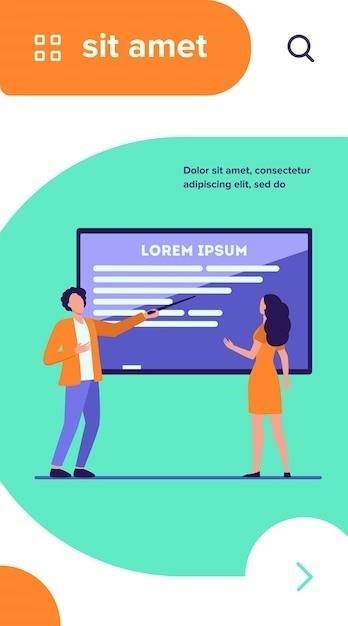Avid Tutorial Request Form⁚ A Comprehensive Guide
This guide provides a comprehensive overview of the Avid Tutorial Request Form (TRF)‚ a crucial tool for AVID students. It details the process from pre-tutorial preparation to post-tutorial reflection‚ emphasizing collaborative learning and effective note-taking strategies. The guide also addresses digital TRF management and resource utilization for optimal learning outcomes.
Understanding the Avid Tutorial Request Form (TRF)
The Avid Tutorial Request Form (TRF) serves as a cornerstone of the AVID program‚ acting as a structured roadmap for both students and tutors. It’s more than just a simple request; it’s a dynamic tool facilitating a collaborative learning experience. The TRF guides students through a systematic process‚ from identifying their Point of Confusion (POC) – the specific area where they need assistance – to documenting their learning journey. This structured approach ensures focused inquiry and efficient use of tutorial time. The form typically includes sections for pre-tutorial preparation‚ where students articulate their understanding and questions; the tutorial process itself‚ encouraging Socratic questioning and collaborative problem-solving; and post-tutorial reflection‚ allowing for assessment of learning and identification of any remaining knowledge gaps. Careful completion of the TRF fosters accountability and maximizes the effectiveness of the tutoring session‚ contributing significantly to student success within the AVID framework. By utilizing the TRF effectively‚ students actively participate in their learning‚ developing crucial self-advocacy and critical thinking skills.
Pre-Tutorial Preparation⁚ Pre-work and Point of Confusion (POC)
Effective pre-tutorial preparation is paramount to a successful AVID tutoring session. Before seeking assistance‚ students must complete any assigned pre-work related to their Point of Confusion (POC). This pre-work might involve reviewing relevant textbook material‚ attempting practice problems‚ or researching the topic independently. The goal is to demonstrate a genuine effort to understand the concept before requesting help. Clearly identifying the POC is critical; students should articulate the specific aspect they’re struggling with‚ formulating a concise and focused question. This necessitates careful self-assessment and critical thinking. Vague or overly broad questions hinder the tutorial’s effectiveness. A well-defined POC allows the tutor to provide targeted support‚ focusing on the precise area of difficulty. The pre-work and POC identification process encourages independent learning and cultivates self-reliance‚ fostering a deeper understanding of the material. This proactive approach transforms the tutorial from a passive knowledge transfer into an active‚ collaborative learning experience. The TRF’s pre-work section serves as a record of this crucial preparatory phase.
The Tutorial Process⁚ Collaborative Inquiry and Socratic Questioning
The AVID tutorial process emphasizes collaborative inquiry‚ moving beyond a simple teacher-student exchange. It’s a dynamic interaction where the tutor acts as a facilitator‚ guiding the student through the problem-solving process rather than directly providing answers. Socratic questioning is central to this approach. Instead of offering immediate solutions‚ the tutor poses carefully crafted questions designed to prompt critical thinking and self-discovery; This encourages the student to actively engage with the material‚ analyze their understanding‚ and identify misconceptions independently. Through a series of probing questions‚ the tutor helps the student uncover their own understanding and arrive at the solution. This method fosters deeper comprehension and retention than passive learning. Effective communication is vital; both student and tutor must articulate their thoughts clearly and actively listen to each other. The collaborative nature of the tutorial encourages a shared responsibility for learning‚ building confidence and problem-solving skills in the student. This process is documented on the TRF‚ highlighting the collaborative inquiry and the use of Socratic questioning techniques.
Three-Column Note-Taking⁚ A Structured Approach to Learning
Three-column note-taking is a structured method integral to the AVID tutorial process‚ promoting active learning and knowledge retention. This technique organizes notes into three distinct columns⁚ the first column outlines the central question or concept being addressed during the tutorial. The second column meticulously records notes and observations made during the tutorial session‚ including key explanations‚ examples‚ and any insights gained. This section serves as a comprehensive record of the learning process. The final column details the steps or processes involved in understanding and resolving the initial question. This might include calculations‚ diagrams‚ or a sequential breakdown of the solution. This methodical approach ensures that students don’t just passively receive information; they actively process it‚ connecting new knowledge to existing understanding. The three-column format facilitates a clear‚ organized record of the learning journey‚ making reviewing and revising the material more efficient. This structured note-taking method enhances comprehension‚ and the resulting notes become valuable study resources. The completed three-column notes are a key component of the student’s tutorial documentation and are often reviewed during post-tutorial reflection.
Post-Tutorial Reflection⁚ Analyzing Learning and Identifying Gaps
Post-tutorial reflection is a critical step in the AVID learning process‚ encouraging students to analyze their understanding and identify any knowledge gaps. This reflective practice goes beyond simply reviewing notes; it involves a deeper engagement with the material‚ evaluating the effectiveness of the tutorial and the student’s participation. Students should consider the clarity of their understanding‚ noting areas where they felt confident and areas where confusion persists. This self-assessment is crucial for identifying specific areas requiring further study or clarification. The reflection process may involve revisiting notes‚ consulting additional resources‚ or formulating new questions to address remaining uncertainties. By actively reflecting on their learning experience‚ students gain a deeper understanding of their strengths and weaknesses‚ fostering a more targeted approach to future learning. This metacognitive process enhances not only content knowledge but also cultivates crucial self-assessment skills‚ essential for lifelong learning. The completed reflection‚ often integrated into the tutorial request form‚ provides valuable feedback for both the student and the instructor‚ informing subsequent learning strategies and support. This reflective practice‚ therefore‚ is vital for optimizing the overall learning outcome.

Digital TRF Management⁚ Streamlining the Process
The transition to digital management of Avid Tutorial Request Forms (TRFs) offers significant advantages in streamlining the entire tutorial process. Digital platforms provide a centralized repository for all tutorial documents and notes‚ eliminating the need for cumbersome physical filing systems. Students can easily access their TRFs‚ notes‚ and other relevant materials from any device with internet access. This accessibility improves organization and reduces the risk of lost or misplaced forms. Furthermore‚ digital platforms facilitate easier sharing of information between students‚ tutors‚ and instructors. This seamless communication enhances collaboration and allows for more efficient feedback and support. Digital TRFs can also be integrated with other learning management systems‚ creating a more cohesive and integrated learning environment. The ability to track tutorial completion‚ progress‚ and overall participation digitally offers valuable data for assessment and program improvement. This data-driven approach allows for better insights into student learning needs and facilitates the development of more effective tutorial strategies. Overall‚ the shift towards digital TRF management represents a significant step towards enhancing efficiency‚ accessibility‚ and the overall effectiveness of the AVID tutorial program.
Utilizing Resources⁚ Textbooks‚ Calculators‚ and Avid Binders
Effective utilization of resources is paramount to a successful AVID tutorial. Students should arrive prepared with necessary materials‚ including their textbook‚ calculator‚ and Avid binder. The textbook serves as a primary source of information‚ providing context and supporting details for the tutorial’s subject matter. A calculator‚ when applicable‚ aids in efficient problem-solving and data analysis‚ ensuring accuracy and speed. The Avid binder acts as a central repository for all course materials‚ including notes‚ handouts‚ and completed assignments. Having these resources readily available streamlines the tutorial process‚ minimizing disruptions and maximizing learning time. The organized nature of the Avid binder allows for quick reference to relevant information‚ fostering a more focused and productive learning experience. This preparedness demonstrates a student’s commitment to active participation and showcases their proactive approach to learning. The effective use of these resources contributes significantly to the overall success of the tutorial‚ ensuring the student gains a thorough understanding of the subject matter. Proper resource management reflects a student’s organized and efficient learning style‚ crucial for academic success within the AVID framework.

Assessment and Grading⁚ Evaluating Student Engagement and Learning
The assessment of student engagement and learning within the AVID tutorial framework utilizes a multifaceted approach. The completed Tutorial Request Form (TRF) itself provides valuable data‚ reflecting the student’s pre-tutorial preparation‚ collaborative inquiry participation‚ and post-tutorial reflection. Specific sections of the TRF‚ such as pre-work completion and collaborative inquiry‚ are graded to evaluate the student’s preparation and engagement during the tutorial session. Observations during the tutorial also contribute to the overall assessment‚ focusing on the student’s active participation‚ effective questioning‚ and resource utilization. The quality of the student’s three-column notes‚ demonstrating comprehension and critical thinking‚ is a key component of the evaluation. Finally‚ the 60-Second Synthesis‚ a concise summary of the learning process‚ assesses the student’s ability to synthesize information and articulate their understanding. This comprehensive assessment strategy ensures a holistic evaluation of the student’s learning experience‚ encompassing preparation‚ participation‚ and comprehension. The grading rubric considers both the quality of the work and the level of student engagement throughout the entire tutorial process. This approach promotes a culture of accountability and reinforces the importance of active participation in the learning process.
Sample Avid Tutorial Request Form and its Components
A typical AVID Tutorial Request Form (TRF) is designed to facilitate a structured learning experience. It typically includes sections for student identification (name‚ period‚ date)‚ subject matter‚ and the essential question driving the tutorial. Crucially‚ a dedicated space allows the student to clearly articulate their Point of Confusion (POC)‚ the specific area requiring clarification. Pre-work completion is documented‚ demonstrating prior engagement with the material. A section for collaborative inquiry notes encourages detailed record-keeping during the tutorial process itself. Following the tutorial‚ students reflect on their learning experience‚ noting any remaining gaps in understanding or areas for further exploration. Space is often provided for tutor feedback‚ offering additional perspectives and guidance. The form may also include a section for assessing the student’s use of resources such as textbooks‚ calculators‚ and the AVID binder‚ demonstrating resourcefulness and effective learning strategies. Some forms might incorporate a rubric or checklist to guide both the student and the tutor‚ ensuring a consistent evaluation process. Ultimately‚ the TRF serves as a dynamic record of the tutorial journey‚ facilitating personalized feedback and tracking academic progress. The form’s components are designed to promote active learning and self-reflection‚ aligning with the AVID philosophy.